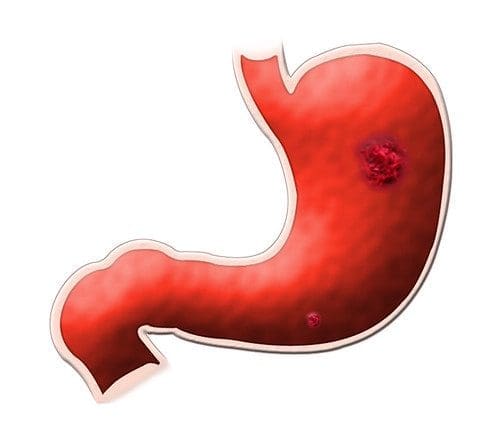Stomach ulcers and gastritis are common digestive conditions that can cause discomfort and pain. Stomach ulcers are open sores that develop on the lining of the stomach, while gastritis is inflammation of the stomach lining.
Both conditions can be caused by a variety of factors, including infection with the bacteria Helicobacter pylori, long-term use of nonsteroidal anti-inflammatory drugs (NSAIDs), excessive alcohol consumption, and stress.
Remember to always consult a medical professional before starting any diet! Due to the recommended consumption of low-fat and high-carb food, low-carb diets are not compatible.
Diet plays a crucial role in managing the symptoms of stomach ulcers and gastritis. Certain foods can aggravate the condition and increase inflammation, while others can help soothe the stomach and promote healing.
Following a proper diet can reduce the symptoms of stomach ulcers and gastritis and improve overall digestive health.
Stomach Ulcers Key Takeaways
- Avoid all processed foods as they contain many chemicals, fat, and other ingredients that can upset a stomach.
- Avoid spicy, acidic, and fatty foods to prevent stomach ulcers and gastritis.
- Easy-to-digest foods like oatmeal, bananas, and boiled potatoes can help soothe the stomach.
- Non-triggering foods like lean proteins, whole grains, and low-fat dairy can be incorporated into a gastritis diet.
- Potatoes have anti-inflammatory properties and can help reduce stomach acid.
- Fiber-rich foods like fruits, vegetables, and whole grains can aid in digestion and promote healing.
Foods to Avoid
Certain foods should be avoided when managing stomach ulcers and gastritis, as they can worsen symptoms and increase inflammation. Spicy foods like chili peppers and hot sauces can irritate the stomach lining and cause discomfort. Acidic foods like citrus fruits and tomatoes can also exacerbate symptoms by increasing stomach acid production.
Fried and fatty foods should be avoided as they can slow down digestion and increase the risk of acid reflux. Alcohol and caffeine are also known to irritate the stomach lining and should be limited or avoided altogether.
Easy-to-Digest Foods
In order to reduce symptoms and promote healing, it is important to include easy-to-digest foods in a diet for stomach ulcers and gastritis. Bananas are a great option as they are gentle on the stomach and provide essential nutrients like potassium. Oatmeal is another easy-to-digest food that can help soothe the stomach lining.
Cooked vegetables, such as carrots, spinach, and zucchini, are also recommended as they are easier to digest than raw vegetables. Lean protein sources, such as chicken, turkey, and fish, are important for maintaining muscle mass and promoting healing.
Non-Triggering Foods
In addition to easy-to-digest foods, non-triggering foods can be included in a diet for stomach ulcers and gastritis. Low-fat dairy products like yogurt and milk are generally well-tolerated and can provide essential nutrients like calcium.
Whole grains, such as brown rice and whole wheat bread, are a good source of fiber and can help regulate digestion. Lean meats and fish are also recommended as they provide important nutrients without adding unnecessary fat.
Fruits and vegetables should be included in a stomach ulcer and gastritis diet, but it is important to choose non-acidic options. Examples include apples, pears, cucumbers, and green beans.
The Benefits of Potatoes
Potatoes are a versatile food that can provide numerous benefits for individuals with stomach ulcers and gastritis. They are high in potassium, which is an essential mineral that helps regulate blood pressure and maintain proper muscle function. Potatoes are also easy to digest, making them a gentle option for those with sensitive stomachs.
Additionally, potatoes can help soothe stomach inflammation due to their high content of resistant starch. Resistant starch acts as a prebiotic, feeding the beneficial bacteria in the gut and promoting a healthy digestive system.
The Role of Fiber in a Gastritis Diet
Fiber plays an important role in digestive health and can be beneficial for individuals with stomach ulcers and gastritis. It helps regulate bowel movements and promotes the growth of beneficial bacteria in the gut. There are two types of fiber: soluble fiber and insoluble fiber.
Soluble fiber can help soothe the stomach lining by forming a gel-like substance that coats the stomach. Good sources of soluble fiber include oats, barley, and legumes. Insoluble fiber adds bulk to the stool and helps prevent constipation. Examples of insoluble fiber-rich foods include whole grains, nuts, and seeds.
When incorporating fiber into a gastritis diet, starting slowly and gradually increasing intake is important to avoid any digestive discomfort. It is also important to drink plenty of water to help the fiber move through the digestive system.
The Importance of Lean Protein
Lean protein is essential for maintaining muscle mass and promoting healing in individuals with stomach ulcers and gastritis. It is important to choose lean sources of protein that are low in fat and easy to digest. Examples include skinless chicken breast, turkey breast, fish, tofu, and eggs.
Including lean protein in meals can help stabilize blood sugar levels and promote satiety, which can be beneficial for individuals with stomach ulcers and gastritis. It is important to cook proteins using healthy cooking methods such as grilling, baking, or steaming rather than frying.
The Healing Power of Probiotics
Probiotics are beneficial bacteria that can help restore balance in the gut and promote a healthy digestive system. They are particularly important for individuals with stomach ulcers and gastritis as they can help reduce inflammation and improve symptoms.
Probiotics can be found in fermented foods such as yogurt, kefir, sauerkraut, and kimchi. They can also be taken as supplements. Choosing probiotic supplements containing strains specifically targeted for digestive health is important.
The Dangers of Spicy Foods
Spicy foods can exacerbate stomach ulcers and gastritis symptoms by irritating the stomach lining. They can cause a burning sensation, increase stomach acid production, and lead to discomfort and pain.
To avoid spicy foods, it is important to read food labels carefully and avoid dishes containing ingredients like chili peppers, hot sauces, and spices like cayenne pepper or paprika. When dining out, it is helpful to ask the server about the spiciness level of dishes and request mild or non-spicy options.
Meal Planning Tips for a Stomach Ulcer and Gastritis Diet
Meal planning is an important aspect of managing stomach ulcers and gastritis. By planning meals in advance, individuals can ensure they are consuming a balanced diet that includes all the necessary nutrients while avoiding trigger foods.
A sample meal plan for a stomach ulcer and gastritis diet could include:
- Breakfast: Oatmeal topped with sliced bananas and a drizzle of honey.
- Snack: Greek yogurt with a handful of almonds.
- Lunch: Grilled chicken breast with steamed vegetables and a side of quinoa.
- Snack: Apple slices with almond butter.
- Dinner: Baked salmon with roasted sweet potatoes and a side salad.
- Snack: Carrot sticks with hummus.
When eating out, it is important to communicate dietary restrictions to the server and ask for modifications if needed. Choosing simple dishes that are grilled or baked rather than fried can help reduce the risk of triggering symptoms.
In conclusion, diet plays a crucial role in managing stomach ulcers and gastritis symptoms. Individuals can reduce inflammation and promote healing by avoiding trigger foods such as spicy, acidic, fried, and fatty foods.
Including easy-to-digest foods like bananas, oatmeal, cooked vegetables, and lean protein sources can help soothe the stomach lining. Non-triggering foods such as low-fat dairy products, whole grains, lean meats and fish, and fruits and vegetables should also be included in a stomach ulcer and gastritis diet.
Incorporating foods like potatoes that are high in potassium and easy to digest can provide additional benefits. It is important to consult with a healthcare professional before making any dietary changes to ensure they are appropriate for individual needs.
If you’re looking for a diet that can help with stomach ulcers and gastritis, you might be interested in this article on celery leaf fennel keto poached salmon. This recipe combines celery and fennel’s anti-inflammatory properties with a ketogenic diet’s health benefits. It’s a delicious and nutritious option that can support your digestive health while still being satisfying. For more information on diets and weight loss, you can also check out these articles on the truth about diet pills and their claims and low carb slow cooker Asian beef.

